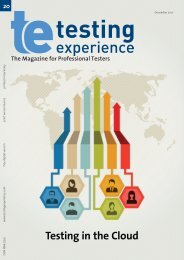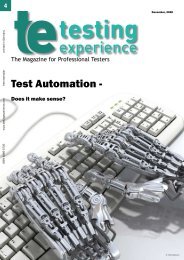Agile Performance Testing - Testing Experience
Agile Performance Testing - Testing Experience
Agile Performance Testing - Testing Experience
Create successful ePaper yourself
Turn your PDF publications into a flip-book with our unique Google optimized e-Paper software.
Figure 2: DBAP Test Data Usage Cube<br />
test stages. Test stages are the different steps in testing addressing<br />
different needs and can be done by different units of the company.<br />
Typical stages are unit tests, integration tests, and acceptance<br />
tests. The exact steps and their names often depend on the<br />
process of the company.<br />
The last dimension is the data purpose. It is the role the data<br />
plays in the DBAP. The actual roles might depend on the concrete<br />
architecture. We have identified the following data purporses<br />
as especially important in our applications: Application processing<br />
data is data everybody is aware of at first glance. Customers<br />
and their financial statements are examples in the context of our<br />
credit rating application. Application meta data is data which<br />
is more or less stable, but influences the “normal” data processing.<br />
An example is tables with credit pricing data. The data determines<br />
the risk-adjusted interest rate<br />
based on the credit score of a company.<br />
If the company has a scoring of “medium”,<br />
the interest rate might be 9.2%. If<br />
the score is “excellent”, the interest rate<br />
might be 3.7%. Control logic data influences<br />
the execution of processes and<br />
workflows. An example would be the ten<br />
million limit for loans. Loans over ten million<br />
demand three persons to check the<br />
rating. Output definition data defines the<br />
design and appearance of reports and<br />
customer output. The bank name “NYC<br />
BANK” or a bank logo are examples. Finally,<br />
configuration data deals with the<br />
IT infrastructure the application is deployed<br />
to. Examples are the configuration<br />
of interfaces, e.g. to SWIFT.<br />
DBAP Correctness<br />
<strong>Testing</strong> aims at finding as many bugs as possible as early as possible<br />
in the development life-cycle. The DBAP shall be or shall<br />
become “correct”. But correctness in the context of DBAPs has<br />
various meanings. A data architect, a database administrator, a<br />
software developer, and a tester might focus on completely different<br />
aspects. To point this out, we present three possible DBAP<br />
correctness concepts (Figure 2): schema correctness, conformity<br />
correctness, and application correctness.<br />
Schema correctness focuses on the database schema the DBAP<br />
uses for storing its data (green). Schema correctness understands<br />
correctness as having (a) a specification that reflects the real<br />
world and (b) an implementation reflecting the specification and<br />
www.testingexperience.com<br />
the real world. Our credit rating application stores financial statements<br />
in the database schema. Schema correctness means in this<br />
context: First, there is one table (or more) for storing the financial<br />
statements. Second, the table has attributes for all the information<br />
provided by financial statements. Third, the financial statements<br />
must refer to the companies they belong to.<br />
Figure 3: DBAP Correctness Criteria<br />
Conformity correctness (brown) focuses on constraints or dependencies<br />
which are not part of the schema. The dependencies between<br />
balance sheet positions and profit-and-loss accounts are a<br />
good example. They are too complex to be reflected by database<br />
constraints. In our example, there are also no constraints in our<br />
database enforcing that the sum of all assets and all liabilities<br />
are equal. The data (and the DBAP) is only conformity-correct if<br />
it reflects also these non-schema-enforced constraints. Conformity<br />
correctness is similar to the concept of assertions in programming<br />
languages such as Java. Assertions do not improve the<br />
quality by looking at the result of actions, but by ensuring that<br />
Figure 4: Understanding DBAP Test Cases (conventional test case: blue, DBAP extension: red)<br />
the preconditions are as they have to be. Whereas these two correctness<br />
criteria focus only on the database, the third criterion,<br />
application correctness, looks at the complete DBAP behavior as<br />
observed e.g. via the GUI. However, it makes sense not to concentrate<br />
only on GUI interactions. Also batch processes such as the<br />
rating calculation procedure P_CALC_RATINGS are relevant. Application<br />
correctness is the most intuitive DBAP correctness criterion.<br />
Thus, we rely on it for discussing DBAP test cases.<br />
Test Cases<br />
Literature defines test cases based on three elements: the procedure<br />
to be invoked and the input and output parameter values.<br />
This model is suitable for stateless applications such as a calculator.<br />
A calculator returns always “7” after pressing “2”, “+”, and “5.”<br />
The Magazine for Professional Testers<br />
17









